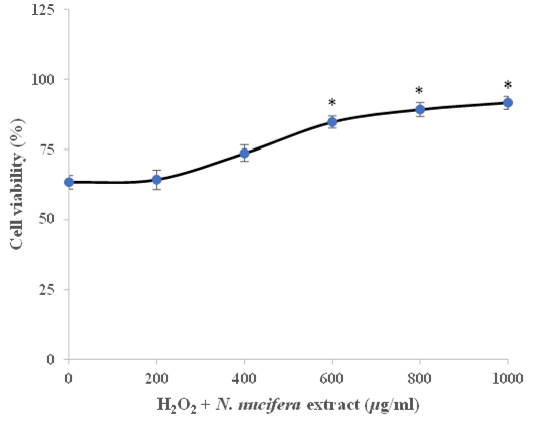Protective effects of Nelumbo nucifera extract on dermal fibroblast against hydrogen peroxide-induced cell toxicity
Keywords:
Nelumbo nucifera, Fibroblast, Hydrogen peroxide, Polyphenol, AntioxidantAbstract
Dermal fibroblasts play a key role in maintaining skin homeostasis by synthesizing and degrading extracellular matrix components. Oxidative stress induced by reactive oxygen species is harmful to the cells, resulting in cellular senescence and premature cell death. The present research work was aimed to evaluate whether Nelumbo nucifera petal extract prevents oxidative stress-induced cell death. Fibroblast cells were exposed to various concentrations of N. nucifera extract (0-1,000 µg/ml) prior to hydrogen peroxide (H2O2) treatment (400 µM). The extract (400-1,000 µg/ml) could increase cell viability significantly after 48-hr H2O2 exposure, while the extract itself was not toxic. Furthermore, the extract was rich in flavonoid and polyphenol content, 26.39±1.94 mgQE/g and 39.26±1.56 mgGAE/g, respectively. That confirmed the in vitro antiradical activity against DPPH and ferric-reducing power. The antioxidant activity of the extract might be plausible for preventing hydrogen peroxide-induced cell death in dermal fibroblasts. Further study should consider the potential of N. nucifera in fibroblast senescence model for anti-aging effect of it.
References
Herb M, Gluschko A, Schramm M. Reactive Oxygen Species: Not Omnipresent but Important in Many Locations. Front Cell Dev Biol. 2021;9:716406.
Brun C, Jean-Louis F, Oddos T, Bagot M, Bensussan A, Michel L. Phenotypic and functional changes in dermal primary fibroblasts isolated from intrinsically aged human skin. Exp Dermatol. 2016;25(2):113-9.
Chen JH, Ozanne SE, Hales CN. Methods of cellular senescence induction using oxidative stress. Methods Mol Biol. 2007;371:179-89.
Bladier C, Wolvetang EJ, Hutchinson P, de Haan JB, Kola I. Response of a primary human fibroblast cell line to H2O2: senescence-like growth arrest or apoptosis? Cell Growth Differ. 1997;8(5):589-98.
Agati G, Azzarello E, Pollastri S, Tattini M. Flavonoids as antioxidants in plants: location and functional significance. Plant Sci. 2012;196:67-76.
Domaszewska-Szostek A, Puzianowska-Kuznicka M, Kurylowicz A. Flavonoids in Skin Senescence Prevention and Treatment. Int J Mol Sci. 2021;22(13).
Yang RZ, Wei XL, Gao FF, Wang LS, Zhang HJ, Xu YJ, et al. Simultaneous analysis of anthocyanins and flavonols in petals of lotus (Nelumbo) cultivars by high-performance liquid chromatography-photodiode array detection/electrospray ionization mass spectrometry. J Chromatogr A. 2009;1216(1): 106-12.
Kim T, Kim HJ, Cho SK, Baek H, Jeon HY, Kim B, et al. Nelumbo nucifera extracts as whitening and anti-wrinkle cosmetic agent. Korean J Chem Engineer. 2011;28:424-27.
Chen G, Zhu M, Guo M. Research advances in traditional and modern use of Nelumbo nucifera: phytochemicals, health promoting activities and beyond. Crit Rev Food Sci Nutr. 2019;59(sup1):S189-S209.
Limwachiranon J, Huang H, Shi Z, Li L, Luo Z. Lotus Flavonoids and Phenolic Acids: Health Promotion and Safe Consumption Dosages. Compr Rev Food Sci Food Saf. 2018;17(2):458-71.
Temviriyanukul P, Sritalahareuthai V, Promyos N, Thangsiri S, Pruesapan K, Srinuanchai W, et al. The Effect of Sacred Lotus (Nelumbo nucifera) and Its Mixtures on Phenolic Profiles, Antioxidant Activities, and Inhibitions of the Key Enzymes Relevant to Alzheimer's Disease. Molecules. 2020;25(16).
La-Ongsri W, Trisonthi C, Balslev H. Management and use of Nelumbo nucifera Gaertn. in Thai wetlands. Wetl Ecol Manag. 2008;17:279-89.
Phimnuan P, Rukchay R, Tiraravesit NW, S.Chaturnratsamee, S., Pittayanurak P, Reutrakul V, Viyoch J. Protective effects of lotus stamen extract on UV-B-irradiated skin cells activities. Songklanakarin J Sci Technol. 2020;42(2):383-90.
Ainsworth EA, Gillespie KM. Estimation of total phenolic content and other oxidation substrates in plant tissues using Folin-Ciocalteu reagent. Nat Protoc. 2007;2(4):875-7.
da Silva LA, Pezzini BR, Soares L. Spectrophotometric determination of the total flavonoid content in Ocimum basilicum L. (Lamiaceae) leaves. Pharmacogn Mag. 2015;11(41):96-101.
Kedare SB, Singh RP. Genesis and development of DPPH method of antioxidant assay. J Food Sci Technol. 2011;48(4):412-22.
Benzie IF, Strain JJ. The ferric reducing ability of plasma (FRAP) as a measure of "antioxidant power": the FRAP assay. Anal Biochem. 1996;239(1):70-6.
Wang Z, Wei D, Xiao H. Methods of cellular senescence induction using oxidative stress. Methods Mol Biol. 2013;1048:135-44.
Charoensin S. Antioxidant and anticancer activities of Moringa oleifera leaves. J Med Plant Res. 2014;527:3-19.
Marinho HS, Cyrne L, Cadenas E, Antunes F. The cellular steady-state of H2O2: latency concepts and gradients. Methods Enzymol. 2013;527:3-19.
Kunanusorn P, Panthong A, Pittayanurak P, Wanauppathamkul S, Nathasaen N, Reutrakul V. Acute and subchronic oral toxicity studies of Nelumbo nucifera stamens extract in rats. J Ethnopharmacol. 2011;134(3):789-95.
Park WH. H2O2 inhibits the growth of human pulmonary fibroblast cells by inducing cell death, GSH depletion and G1 phase arrest. Mol Med Rep. 2013;7(4):1235-40.
Cox AG, Winterbourn CC, Hampton MB. Mitochondrial peroxiredoxin involvement in antioxidant defence and redox signalling. Biochem J. 2009;425(2):313-25.
Rhee SG, Kil IS. Mitochondrial H2O2 signaling is controlled by the concerted action of peroxiredoxin III and sulfiredoxin: Linking mitochondrial function to circadian rhythm. Free Radic Biol Med. 2016;100:73-80.
Lagoa R, Graziani I, Lopez-Sanchez C, Garcia-Martinez V, Gutierrez-Merino C. Complex I and cytochrome c are molecular targets of flavonoids that inhibit hydrogen peroxide production by mitochondria. Biochim Biophys Acta. 2011;1807(12):1562-72.

Downloads
Published
How to Cite
Issue
Section
License
Copyright (c) 2023 Naresuan Phayao Journal

This work is licensed under a Creative Commons Attribution-NonCommercial-NoDerivatives 4.0 International License.
ผู้นิพนธ์ต้องรับผิดชอบข้อความในบทนิพนธ์ของตน มหาวิทยาลัยพะเยาไม่จำเป็นต้องเห็นด้วยกับบทความที่ตีพิมพ์เสมอไป ผู้สนใจสามารถคัดลอก และนำไปใช้ได้ แต่จะต้องขออนุมัติเจ้าของ และได้รับการอนุมัติเป็นลายลักษณ์อักษรก่อน พร้อมกับมีการอ้างอิงและกล่าวคำขอบคุณให้ถูกต้องด้วย
The authors are themselves responsible for their contents. Signed articles may not always reflect the opinion of University of Phayao. The articles can be reproduced and reprinted, provided that permission is given by the authors and acknowledgement must be given.







